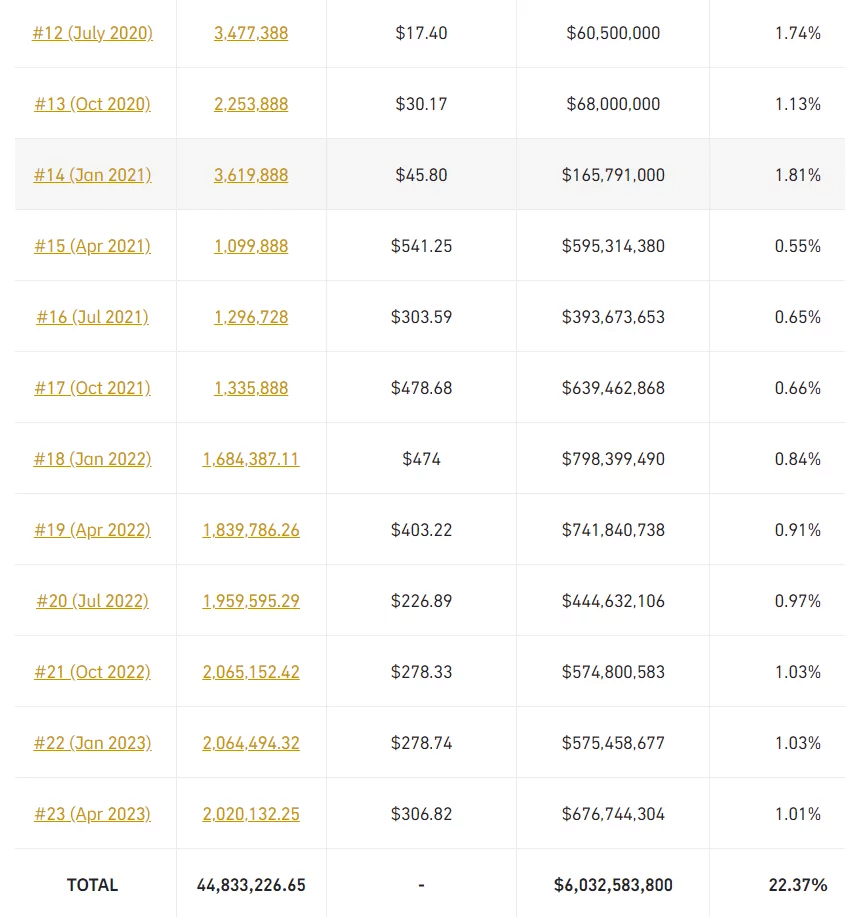484 million dollars: this is the amount represented by the 2 million BNBs recently deleted from the BNB Chain blockchain. The operation was prompted by BNB’s quarterly burn, during which Binance burns a quantity of BNB, defined by a precise formula, in order to make its cryptocurrency deflationary. But is this economic system really effective?
New quarterly BNB burn
Since launching its platform and token in 2017, exchange Binance has been regularly removing its outstanding BNBs. During the 24th quarterly burn, nearly 2 million tokens were burned, the equivalent of $484 million.
This operation is the third of its kind to take place in 2023, the previous two having taken place in January and April of this year respectively:

History of the various BNB burns between July 2020 and April 2023
To estimate in advance the number of NBBs that will be removed from the NBB Chain during the next burn, here is the formula provided by Binance:
- multiply by 1,000 the number of blocks produced on the BNB Chain in a quarter;
- add the price of a BNB in dollars by a constant value, currently 1,000 (this value may be changed by governance);
- divide the total to obtain the number of BNB to be burned in a quarter.
Note that Binance’s quarterly burn is made up of two different components: the “Real Burn”, which refers directly to the NBI burned using the formula, and the Pioneer Burn Program. The latter provides financial compensation to users who have lost their funds by mistake using the BNB Chain
The relative efficiency of the BNB burn
Binance is looking to convince investors by taking the gamble on a deflationary cryptocurrency. According to the exchange, a steady reduction in the number of tokens in circulation can lead to an increase in the BNB price:
” By making the currency rarer, the burn of units aims to create a deflationary effect and potentially increases the crypto’s valuation to the benefit of its holders. For BNB, the aim of burns is to gradually reduce its total supply until it is below 100 million BNB. “
Originally, 200 million BNB tokens were issued by Binance and split between the exchange and its various investors. After 6 years, only 153 million BNB remain in circulation on the network. At the current rate, it will take more than 7 years to burn off the second half of the tokens concerned by the burn mechanism.
As for the real effectiveness of this deflationary measure, it is difficult to say to what extent it will influence the BNB price over the long term. In fact, inflationary cryptocurrencies perform just as well as their deflationary counterparts, such as Bitcoin (BTC) and the former Ether (ETH).
In reality, only hyperinflation can devalue a cryptocurrency. Moreover, this phenomenon is not unique to the world of the Web3: when certain central banks print too much new liquidity, fiat currencies lose value.
Similarly, some cryptocurrencies, such as the Shiba Inu meme coin, rely on multiple burns to encourage investors to inject capital.
In addition, deflationary tokenomics can boost a cryptocurrency’s price only if it has solid fundamentals upstream, involving real use cases that meet specific needs.
